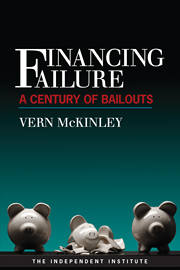It was two years ago this month that President Obama signed the massive Dodd-Frank Wall Street Reform and Consumer Protection Act.
The act mandated a rare event: the elimination of a federal agency, the Office of Thrift Supervision. But it also created two new agencies: the Consumer Financial Protection Bureau and the Financial Stability Oversight Council (FSOC).
The latter, supported by Treasury’s new Office of Financial Research (OFR), was created to serve as an advance warning system “to identify and address systemic risks posed by large, complex companies, products, and activities before they threaten the stability of the economy.” But as we saw from the trading losses at J.P. Morgan Chase earlier this year and from the collapse of MF Global late last year, the FSOC has proven incapable of the promised oversight—and no amount of money or bureaucracy is likely to improve the situation.
The idea of a Washington bureaucracy serving as a watchdog for the financial system is not new. Indeed, that’s exactly what Sen. Claude Swanson of Virginia had in mind when he shepherded the Federal Reserve Act through Congress in 1913 for President Woodrow Wilson: “These reserve banks, practically under Government control and supervision, having a broad vision of financial matters, can be used to prevent dangerous inflation or ruinous depression,” Swanson argued. “They will have a steadying influence on the finances of the country and produce that stability which is the most propitious for the growth and development of the Nation.”
Within two decades of its creation, the Fed presided over, and many believe caused, the most ruinous economic meltdown in U.S. history, the Great Depression.
Another attempt to create a committee with a holistic vantage point of the financial system came after the stock market crash of 1987, when President Ronald Reagan signed Executive Order 12631 creating the Working Group on Financial Markets.
Headed by the Secretary of the Treasury, this Working Group also included the chairs of the Federal Reserve System, the Securities and Exchange Commission (SEC) and the Commodity Futures Trading Commission (CFTC). The idea was to make sure that key financial industry regulators stayed on top of important developments throughout the sector.
As we now know, this did little to forestall the recent financial crisis.
In On the Brink: Inside the Race to Stop the Collapse of the Global Financial System, his book on the crisis, former Treasury Secretary Henry Paulson offers the example of a proposed Working Group “scenario analysis” intended to examine the possible failure of Fannie Mae. The exercise never took place, however, because planners feared that word would leak out to the media. So the proposed exercise, the financial equivalent of Pentagon war-gaming, was quashed.
In Washington, when a bureaucracy fails to accomplish its assigned goal politicians typically don’t do away with the agency, they create another agency with the same goal. That’s how we got the FSOC.
The FSOC began to take shape during the run-up to Dodd-Frank, as the Obama administration developed its initial financial reform proposal. Instead of four members, like the Working Group, the FSOC would have 10 members, and would have more resources, more powers and require more reports to be submitted by financial institutions. This hasn’t worked either.
For proof, fast forward to May 2012,when Treasury Secretary Timothy Geithner, who chairs the FSOC, described the billions of JPMorgan losses and the collapse of MF Global as two of the most serious tests of the financial system since the 2008 financial crisis.
Media reports on the JPMorgan losses surfaced in April, while the FSOC took up the matter at a meeting on May 22. Not much of an advance warning system. As for MF Global, the council reviewed the MF Global meltdown at an October 31, 2011 meeting, the same day the company filed for Chapter 11 bankruptcy protection.
What did the FSOC know in advance and when did they know it? To find out, we filed a Freedom of Information request with FSOC for any internal analysis on MF Global. FSOC provided just two documents: a one page script for Secretary Geithner for the October 31 meeting and a meeting notice.
Will the FSOC ever be able to fulfill its mission? That is highly questionable. A recent Treasury Department Inspector General report, for example, lambasted the OFR, which is supposed to support FSOC’s watchdog efforts, because after two years “efforts to establish the office are still in progress.”
There are other problems as well.
Instead of installing leadership with a strong background in the management of large financial institutions, or with a background in regulating such institutions, the Obama administration appointed Amias Gerety to lead the council. Gerety’s experience includes stints as an entry-level consultant at Oliver Wyman, a year with the John Kerry presidential campaign, and brief stints at two nonprofits: the Center for American Progress and Save the Children.
The FSOC’s unwieldy bureaucracy and weak, politicized leadership—haplessness in the face of crisis—are hallmarks of modern Washington governance.
At this point, the Financial Stability Oversight Council clearly is incapable of providing either financial stability or oversight. It should be eliminated.







